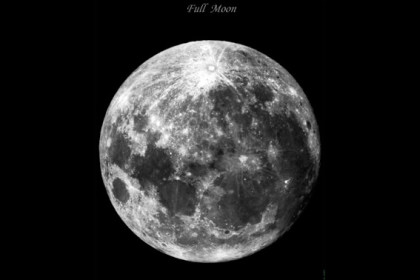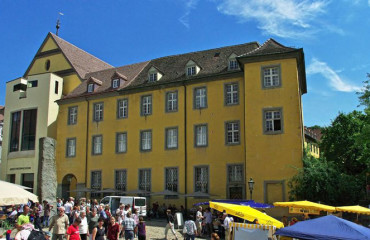
THE PLANETS
MERCURY: visible very low on the horizon at dawn, up to day 14, then becomes invisible in conjunction with the sun.
VENUS: still present as the most visible star of the evening sky, on day 15 it is stationary, the visibility decreases rapidly and at the end of the month sets only 35 minutes after the sun. In the last few days it is useful to catch it with our telescopes to see the planet’s atmospheric features.
MARS: visible for most of the night; the planet is reduced in size throughout the month, falling below 10″, and taking on positive values of magnitude in brightness, so you may find the visual and photographic observations of scientific interest .
JUPITER: theoretically visible until day 4 in the light of dusk. On the 13th day it is in conjunction with the Sun so invisible and will reappear during dawn only on the last day of the month.
SATURN: this month it is the planet on which we focus our interest; visible for most of the night among the stars of the constellation Virgo, it appears in the early evening so you can observe and film comfortably after dinner without waiting for hours.
URANUS: undetectable until mid-month, after which it rises just before astronomical twilight.
NEPTUNE: visible in the second half of the night, earlier in the month it rises 45 minutes before sunrise, and at the end of the month it appears during the twilight hours.
A DOUBLE STAR EACH MONTH
In the month of May, we can enjoy the sky from dusk to dawn without the annoying company of mosquitoes…you could then grasp a unique experience to pass time while observing the passage of the constellations. In fact, for a few moments at sunset, we can see Orion, the winter constellation, in addition the Swan summer constellation will be visible at dawn. I realize it will not be easy because of the usual light pollution: a time to admire the sky was enough to go into the backyard, now you have to go about fifty miles, it is the price you pay for the “progress” that brought us the triplet apochromatic but canceled the beauty of the firmament. But I am sure that this effort will be repaid, because they allow us not only to understand the sense of time but also to exercise our thinking.
With the passage of time and the transit of the constellations, our attention focuses on the central star of the tail of the Big Dipper, the easiest and most famous double star in the sky, Mizar, the brightest, and the other, Alcor, the weakest. The ancient Greeks and Arabs used this binary system as a test for assessing visual acuity. The Mizar-Alcor pair is known by many names and meanings, for example, to Native Americans, Mizar is a hunter holding a pot chasing a bear, Alcor. Watching with my small telescope Mizar 60mm fluorite, which in turn is known to double, this starlet mag.4 discovered in 1650 by our Giovanni Battista Riccioli. The same tool that allows us to split Mizar and Alcor among this last also shows a star 8mag, Sidus Ludovicianum, so named in 1723 by a German amateur astronomer to honor her prince.
THE OBJECT OF THE MONTH: THE SPIRAL GALAXY NGC 4565
NGC 4565 is a beautiful spiral galaxy identified in the vicinity of the star Gamma the Coma Berenices. Observing it with a common 10×50 binoculars or a telescope of only 90-100mm diameter, you will see a faint band of light, very long (about 8′ or 10′), which in the central part seems to swell and increase in brightness. NGC 4565 is one of the finest examples of a spiral galaxy seen perfectly cut. Using a 20cm telescope under ideal skies is noted that NGC 4565 stretches thin for almost 13′, the central area appears brighter and larger than 2′. Struggling a little with the eye is noted that this long strip of light is not uniform but crossed throughout its length by a narrow dark band, mostly marked in the middle and end. The dark band was detected for the first time by Lord Rosse in 1855, who in drawing it clearly identified the presence of something dark that bisects the galaxy. In photography, enjoying the beauty of the entire subject: the dark band divides the galaxy into two parts and at the ends with a life together of very thin dark filaments that intertwine with each other.
NGC 4565 is 32 million light years from us, its mass is almost 224 billion solar units, and its brightness is 21 billion times greater than that of the Sun, and is moving away from us at a speed of 112km per second. Other celestial objects observed in this period with an ordinary pair of binoculars: Cluster of Galaxies in Coma Berenices. Most important: NGC 4565-M 98 – M 99-M 100 Cluster of Galaxies in Virgo. Most important: M 104 (Sombrero) M 60 – M 49 – M 87 Open Cluster M 44 (Nativity) in Cancer Galaxies M 51 and M 101 in Ursa Major Galaxies M 81 and M 82 in Ursa Major Trio of Galaxies in Leo M 65 – M 66 – NGC 3628 and M 96 – M 95 and M 105
THE SPRING
With the arrival of spring the days are getting longer and the nights are getting shorter and warm. The observation of the sky during this season is certainly less tiring and more enjoyable. The constellation of reference for the spring is Ursa Major, in particular the part that includes the tail of Ursa, also called the Big Dipper. In this period the Big Dipper is well visible and Zenith is easily identifiable by the seven stars that compose it. Starting with the Big Dipper, it is possible to recognize the three stars Regulus, Arcturus and Spica, forming the so-called Triangle Spring. To find Regulus in the Constellation Leo, it is sufficient to extend southward the bow of the Polar Star and the two stars of the Big Dipper, Dubhe and Merak: Regulus is the brightest star that is encountered in the extension.
To find Arcturus and Spica it is necessary to extend the arch formed by the first three stars of the Big Dipper (Alioth, Mizar and Benetnasch), forming the helm of the Big Dipper. The first bright star, Arcturus in Bootes will meet the second Spica in Virgo. First locate the Big Dipper and then the Lion, Virgo and Bootes, you will be able to find all the other Spring Constellations. During this season, you can see two meteor showers. The first shower is called the Lyrids because the meteors seem to originate from the constellation Lyra, it is seen in the second half of the night: for it is said that the Lyrids have the radiant in Lyra. It is not very rich, and a shower consisting of fast meteors, the maximum intensity reached on April 21, lasts from 19 to 22 April. Another spring shower is called Eta Aquarids, it presents the radiant in Aquarius and the maximum on 4 May. The shower lasts 1 -13 May and is formed by rapid meteors that leave long tracks.
EVENTS OF THE MONTH
3 April at 18:16 – Moon conjuncts with Regulus (Moon 6.3° north of Alpha Leonis, the best conditions for observation after sunset is at 20:10)
May 1 at 5:46 – Moon conjuncts with Regulus (Moon 7° south of Alpha Leonis)
May 1 at 10:00 – Max libration lunar latitude. Visibile the north pole (+6°,8)
May 4 at 18:28 – Moon conjuncts with Spica (Luna 1, 9 south of Alpha Virginis), improved observance conditions shortly after sunset, around 20:40
May 4 at 23:39 – Moon conjuncts with Saturn (Moon 7° south of Saturn 3)
May 5 at 21:00 – Max Eta Aquarids meteor shower, observed from 18 April to 27 May
May 6 at 05:33 – Moon at perigee (356.955 Km)
May 6 at 05:35 – Full Moon
May 7 at 08:07 – Venus in conjunction with El Nath (Venus 49’ south of Beta Tauri)
May 12 at 11:00 – Maxim librazione lunar in longitude. Visible the patch occidental (+7°,42)
May 12 at 23:46 – Moon at last quarter
May 13 at 23:00 – Maxim lunar libration in latitude. Visible the South Pole (-6°,81)
May 19 at time 18:13 – Moon at meridian (406.448Km)
May 21 at 01:47 – New Moon
May 21 at 01:53 – Eclisse Anulare of Sun, not visible froma Italy. Visible in China, Japan,librazione, U.S.A.
May 21 at 03:01 – Saturn at minimum distance from Spica (Saturn 4°,8 in north of Alfa Virginis)
May 22 at 23:46 – Moon and Venus in conjunction (moon 5°,5 south of Venus ); the best condition of observability before that the Moon sets, about at 22:00
May 28 at 00:00 –Maxim lunar libration in longitude. Visible the patch oriental (-7°,41)
May 28 at 22:15 – Moon at first qaurter
 English
English  Italiano
Italiano 



